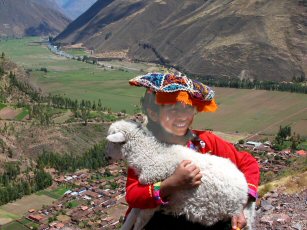Peru Shopping: High Finance in Changing Money
Note: This changing money page is part of a series of blogs that we did while learning Spanish language in Peru. Each blog focuses on real life examples of how we crafted our foreign language course. They are designed so show you how to create your own Walkabout foreign language course. Use our examples here for any language you want to learn. See the "More Peru Stories" list of links on this page for additional language learning strategies. Also see our Learn Spanish section.
Ready for a poignant lesson about changing money? You're in back-country Peru shopping for grandkid trinkets. You find charming finger puppets – 1 sol each (33 US cents).
You choose three animals revered in Peru, a puma, a condor, and a snake, representing the present world, the over-world, and the underworld. But the smallest bill you have is 50 soles, and changing money is out of the question for these child-vendors. Wait, four of those American quarters jangling in your pocket would buy the puppets. American money is good anywhere, right? Wrong. . . Here's why.
We're touring the Sacred Valley, a ribbon of fertile farmland and picturesque villages nestled beside the Rio Urubamba and ringed by jutting mountain peaks. This was the heart of the Inca empire. We stop now and then to marvel at small Inca ruins; at pre-Inca terraces still in use; at a couple of spectacular overlooks. We spent an hour wandering the Pisac handicraft market. See reviews on TripAdvisor.
At each stop we're besieged by kids trying to sell us something: "My picture – one sol," says a miniature girl decked out in colorful Incan dress, a tiny lamb cuddled in her arms. "Post cards – one sol," urges one little urchin, tugging at our sleeves. Others push bottled water, wrist bands, shoe shines, finger puppets, animal-shaped pottery flutes, and more. One kid urges me to buy his hand-painted art. "My name is Pablo Picasso. I painted these myself." After a day of this, I want to sweep them aside – but they're too cute, too persistent.
Our last stop for the day: we've climbed the Inca ruins at Ollantaytambo and are trudging back to the bus. I'm the last one. Somehow I've fallen in with a pack of chattering kids. Who knows what they're pitching; I’ve tuned them out.
More Peru Stories
Intensive Spanish
"De donde es Usted, señor, where are you from?" a ten-year-old girl beside me asks politely.
"Los Estados Unidos."
"¿Los Estados Unidos? Your president is George Bush," she says in thick English. "Your capitol is Washington."
I stop, look down at her in surprise.
She grins. She knows she's got me. She reaches into her pocket, pulls out a handful of coins, begins pawing through them. The gaggle of kids gathers around. Eight of them.
She selects an American quarter, another one, a third, and a fourth. "American!" she says, and hands them to me. Then she digs out a couple of large copper-colored coins.
"No, these aren't American," I say.
Like a school teacher, she spells out an inscription, "Estados Unidos . . ." and looks up triumphantly, overlooking the third word: ". . . Mexicanos."
I read her the whole inscription. "These are Mexican, not American," I say.
She doesn't believe me. She spells out the first two words again. I finally convince her.
Her goal, I realize, is changing money: she wants me to exchange the American coins for Peruvian soles.
We chat, she and I hunkered on the ground searching through her coins, the other kids crowding in. She's got coins from all over. Several of the kids do. Tourists give them the coins, or insist on buying things with them. But foreign coins are useless: vendors can't accept them because when they are changing money, the banks only accept bills.
Twenty yards away, the bus driver honks.
I give the girl three sols for her quarters – a fair rate: 3 soles for 1 dollar. I want to stay and chat. These kids can teach me some things. "I have to go. They’re waiting," I say. I stand, turn to leave.
"Si," she says. She’s smiling, like a friend. "Adiós, señor. Gracias por su ayuda."
If you'd like to learn more about how you can benefit from simple language learning lessons like these, download the Walkabout Language Learning Action Guide. It shows you how to use your daily interactions -- whether it is changing money or making small talk -- to create your own custom-made language program.
Lessons Learned While Changing Money
- Things are never as they seem at first glance
- Language and culture teachers can come in all sizes, even pint-size
And
- Always carry small change in the local currency; don't try to pay for purchases with foreign coins
--Posted by Terry, October 21
← Previous: Real Life Practice Next: Mario Vargas Llosa Teaches →
Return from Changing Money to Language Lore
Return to Your Language Guide home
Stay in Touch with Language Lore ezine
Want to stay in touch? Subscribe to Language Lore, our internet language learning email newsletter. This free ezine facilitates your language learning journey. See our back issues here.
Go to your email now to confirmation your subscription. If you don't see an email within an hour (check your junk mail folder too), please contact us. We respect your privacy and never sell or rent our subscriber lists. If you want to get off this list later, one click unsubscribes you.


New! Comments
Have your say about what you just read! Leave me a comment in the box below.